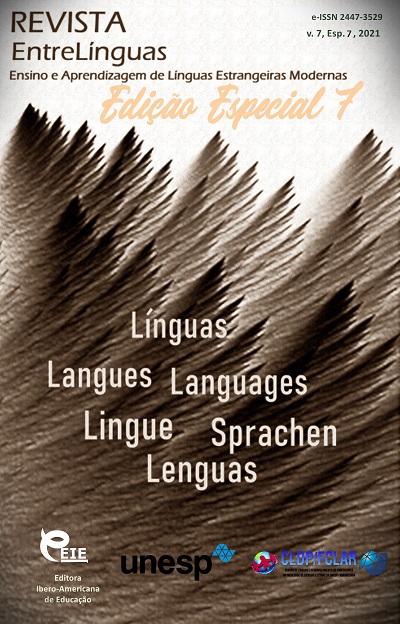La construal del concepto de memoria en inglés
DOI:
https://doi.org/10.29051/el.v7iesp.7.16297Palabras clave:
Memoria, Verbo, SemánticaResumen
Este estudio trata la interpretación y perspectiva del concepto de memoria en el inglés moderno. Utilizando datos del British National Corpus y varias fuentes literarias, examinamos el campo léxico de los verbos de memoria. Empleando el modelo analítico de Frame Semantics, la investigación demuestra cómo una combinación de características semánticas y análisis de marcos puede capturar las diversas formas en que el inglés construye el concepto de memoria y recuerdo.
Descargas
Citas
ARUTYUNOVA, N.D. Tipy yazykovyh znacheniy [Types of Linguistic Meanings: Evaluation. Event. Fact.]: Ed N.D.Arutyunova. – Мoscow: 340 p. (in Russian). 1988.
BARANOV, A.N., DOBROVOLSKY, D.O. Postulaty kognitivnoy semantiki [Postulates of cognitive semantics]. Izvestiya AN. Ser. lit. and yaz., 56 (1): 11-21. (in Russian). 1997.
BELYAEVSKAYA, E.G. Semanticheskaya struktyra slova v nominativnom i kommunikativnom aspektah [Semantic structure of the word in nominative and communicative aspects]: Dis....Doctor of Philology. – M.: 401 p. (in Russian). 1992.
DEMYANKOV, V.Z. Kognitivnaya lingvistika kak raznovidnost interpretiruyushchego podhoda [Cognitive linguistics as a kind of interpreting approach]. Voprosy yazykoznaniya, 4: 17-33. (in Russian). 1994.
DIRVEN, R. ET AL. The scene of linguistic action and its perspectivization by Speak, Talk, Say, and Tell, Amsterdam: Benjamins. 1982.
FAUCONNIER, G. Mental Spaces: Aspects of Meaning Construction in Natural Language. Cambridge: CUP. 1984.
FILLMORE, C., ATKINS, B. “Toward a frame-based lexicon: The semantics of risk and its neighbours”, A., Lehrer & E. Kittay eds., Frames, Fields, and contrasts: New Essays in Semantic and Lexical Organisation, 75-102. London: Erlbaum. 1992.
FILLMORE, C. “Frame Semantics”, Linguistic Society of Korea ed., Linguistics in the Morning Calm, 111-138. Seoul: Hanshin. 1982.
GIBBS, R.W. What’s Cognitive About Cognitive Linguistics. Cognitive Linguistics in the Redwoods: The Expansion of a New Paradigm in Linguistics. – Berlin, N. Y.: 27-53. 1996.
LAKOFF, G. Women, Fire, and Dangerous Things. Chicago: UCP. 1987.
LANGACKER, R. Foundations of Cognitive Grammar, Vol. 1, Theoretical Prerequisites, Stanford: SUP. 1987.
MINSKY, M. “A framework for representing knowledge”, P. Winston ed., The Pschology of Computer Vision, 211-277. New York: McGraw-Hill. 1975.
TALMY, L. Lexicalization Patterns: Semantic Structure in Lexical Forms. T. Shopen (ed.) Language Typology and Syntactic Description. Vol. Ш: Grammatical Categories and the Lexicon. – Cambridge: 46-149. 1985.
TAYLOR, J.R. Linguistic Categorization: Prototypes in Linguistic Theory. Bd. 149 – Oxford: Clarendon Press: 326.1995.
ZINCHENKO, T.P. Kognitivnaya I prikladnaya psihologiya [Cognitive and applied psychology] – Moscow: Mosk. Psychological and Social Institute, Voronezh: Publishing House of NGO "MODEK": 608 p. (in Russian). 2000.
Descargas
Publicado
Cómo citar
Número
Sección
Licencia

Esta obra está bajo una licencia internacional Creative Commons Atribución-NoComercial-CompartirIgual 4.0.
Os manuscritos aceitos e publicados são de propriedade da Revista EntreLínguas. Os artigos publicados e as referências citadas na Revista EntreLínguas são de inteira responsabilidade de seus autores.
Transferência de direitos autorais – autorização para publicação
Caso o artigo submetido seja aprovado para publicação, já fica acordado que o(s) autor(es) autoriza(m) a UNESP a reproduzi-lo e publicá-lo na EntreLínguas, entendendo-se os termos “reprodução” e “publicação” conforme definição respectivamente dos incisos VI e I do artigo 5° da Lei 9610/98. O artigo poderá ser acessado pela rede mundial de computadores (Internet), sendo permitidas, a título gratuito, a consulta e a reprodução de exemplar do artigo para uso próprio de quem a consulta, desde que haja a citação ao texto consultado. Essa autorização de publicação 328 EntreLínguas, Araraquara, v. 1, n .2, p. 323-328, jul./dez. 2015 não tem limitação de tempo, ficando a UNESP responsável pela manutenção da identificação do(s) autor(es) do artigo. Os artigos publicados e as referências citadas na Revista EntreLínguas são de inteira responsabilidade de seus autores.











